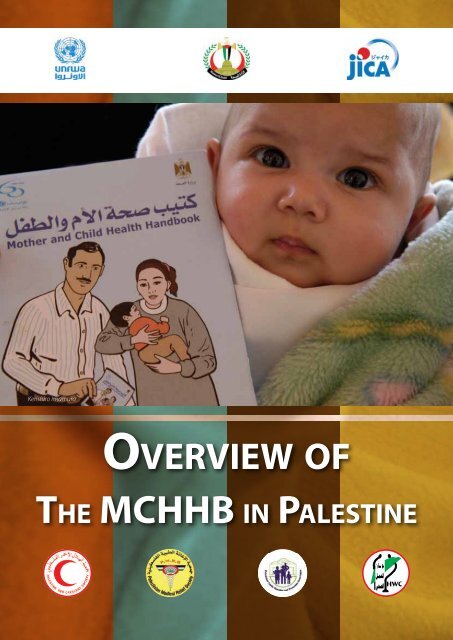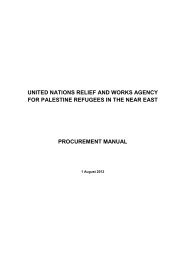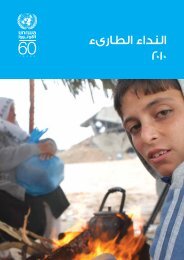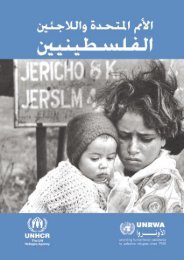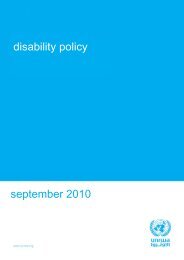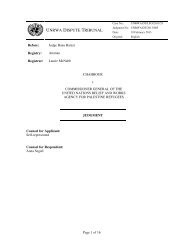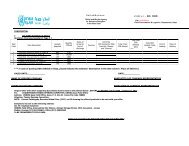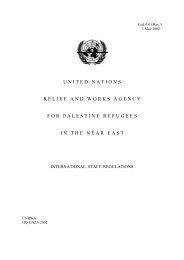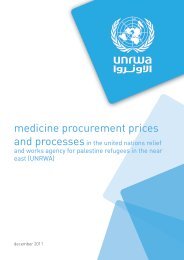Overview of the Mother and Child Health Handbook in ... - Unrwa
Overview of the Mother and Child Health Handbook in ... - Unrwa
Overview of the Mother and Child Health Handbook in ... - Unrwa
- No tags were found...
Create successful ePaper yourself
Turn your PDF publications into a flip-book with our unique Google optimized e-Paper software.
About JICA’s support for <strong>the</strong> MCHHBJICA has supported <strong>the</strong> Palest<strong>in</strong>ian MCHHB <strong>in</strong> two phases. Dur<strong>in</strong>g <strong>the</strong> first phase from 2005 to 2008, JICA supported<strong>the</strong> development <strong>of</strong> <strong>the</strong> Palest<strong>in</strong>ian MCHHB. (see BOX1 for fur<strong>the</strong>r details). After <strong>the</strong> development stage <strong>of</strong> <strong>the</strong>MCHHB, <strong>the</strong> M<strong>in</strong>istry <strong>and</strong> JICA launched a subsequent project entitled “Project for Improv<strong>in</strong>g Maternal <strong>and</strong> <strong>Child</strong><strong>Health</strong> <strong>and</strong> Reproductive <strong>Health</strong> <strong>in</strong> Palest<strong>in</strong>e (Phase2)” dur<strong>in</strong>g <strong>the</strong> period from 2008 to 2012, aim<strong>in</strong>g to improve <strong>the</strong>service <strong>and</strong> management related to MCH/RH <strong>and</strong> to promote <strong>the</strong> cont<strong>in</strong>uum <strong>of</strong> care among health care providersthrough fur<strong>the</strong>r expansion <strong>and</strong> utilization <strong>of</strong> <strong>the</strong> MCHHBs. Dur<strong>in</strong>g <strong>the</strong> second phase, <strong>the</strong> National Coord<strong>in</strong>ationCommittee for <strong>the</strong> MCHHB (NCC/MCHHB) was established, <strong>and</strong> about 900 health care providers (government <strong>and</strong>NGOs) were tra<strong>in</strong>ed <strong>in</strong> management <strong>and</strong> utilization <strong>of</strong> <strong>the</strong> MCHHB; <strong>in</strong> addition, over 560 doctors/nurses/midwives/village health workers were provided tra<strong>in</strong><strong>in</strong>gs related to antenatal care throughout <strong>the</strong> West Bank.Box 1: Story about <strong>the</strong> Development <strong>of</strong> <strong>the</strong> MCHHB <strong>in</strong> Palest<strong>in</strong>eThe birth <strong>of</strong> <strong>the</strong> Palest<strong>in</strong>ian MCHHB was <strong>in</strong>itiated by <strong>the</strong> “Project for Improv<strong>in</strong>g Reproductive<strong>Health</strong> with a Special Focus on Maternal <strong>and</strong> <strong>Child</strong> <strong>Health</strong> <strong>in</strong> Palest<strong>in</strong>e (Phase 1)” implemented by JapanInternational Cooperation Agency (JICA) <strong>and</strong> <strong>the</strong> Palest<strong>in</strong>ian M<strong>in</strong>istry <strong>of</strong> <strong>Health</strong> from 2005 to 2008.The needs for <strong>the</strong> MCHHB were emphasized by bitter experience <strong>of</strong> <strong>the</strong> second <strong>in</strong>tifada <strong>in</strong> 2000. Dur<strong>in</strong>g<strong>the</strong> time <strong>of</strong> emergency, which occurred not long time before <strong>the</strong> project started, many pregnantwomen faced difficulties <strong>in</strong> access<strong>in</strong>g health facilities <strong>and</strong> <strong>in</strong> receiv<strong>in</strong>g <strong>the</strong> necessary care because <strong>of</strong>limited mobility, curfews or sudden closure <strong>of</strong> areas. The cont<strong>in</strong>uum <strong>of</strong> care was totally disconnected,<strong>and</strong> per<strong>in</strong>atal care services were fragmented <strong>and</strong> uncoord<strong>in</strong>ated. Although <strong>the</strong> situation improved <strong>and</strong>became more stable after <strong>the</strong> <strong>in</strong>tifada, <strong>the</strong> proposal for <strong>the</strong> MCHHB was brought from Japan to fill <strong>the</strong>rema<strong>in</strong><strong>in</strong>g gap caused by <strong>the</strong> situation.Dur<strong>in</strong>g <strong>the</strong> Project (Phase 1), <strong>the</strong> Palest<strong>in</strong>ian MCHHB, <strong>the</strong> first <strong>in</strong> Arabic language, was developed <strong>and</strong>was utilized <strong>in</strong> Ramallah <strong>and</strong> Jericho as pilot, <strong>the</strong>n rapidly exp<strong>and</strong>ed nationwide from 2008.Regard<strong>in</strong>g <strong>the</strong> process <strong>of</strong> develop<strong>in</strong>g <strong>the</strong> MCHHB, it is particularly noteworthy that <strong>the</strong> M<strong>in</strong>istry <strong>and</strong><strong>the</strong> Japanese experts tried to develop a “Palest<strong>in</strong>ian” MCHHB, not as a replication <strong>of</strong> <strong>the</strong> Japanese MCHHB,by address<strong>in</strong>g issues <strong>in</strong> <strong>the</strong> health sector <strong>and</strong> harmoniz<strong>in</strong>g with <strong>the</strong> exist<strong>in</strong>g health system <strong>in</strong> Palest<strong>in</strong>e. Forexample, <strong>the</strong> health education <strong>in</strong>formation <strong>in</strong>cluded <strong>in</strong> <strong>the</strong> MCHHB was coord<strong>in</strong>ated with <strong>in</strong>formationauthorized <strong>and</strong> st<strong>and</strong>ardized by <strong>the</strong> National Committee for <strong>Health</strong> Education <strong>and</strong> <strong>Health</strong> Promotion.Very important momentums forturn<strong>in</strong>g <strong>the</strong> MCHHB <strong>in</strong>to <strong>the</strong> nationalcommon tool was <strong>the</strong> decision<strong>of</strong> UNRWA (UN organization thatprovides health <strong>and</strong> social servicesto Palest<strong>in</strong>ian refugee), <strong>and</strong> <strong>of</strong> somemajor NGOs to stop us<strong>in</strong>g <strong>the</strong>irown MCH-related cards <strong>and</strong> use <strong>the</strong>MCHHB. In addition, UNRWA alsocooperated <strong>in</strong> try<strong>in</strong>g <strong>the</strong> pilot-typeMCHHB at <strong>the</strong>ir health centres dur<strong>in</strong>g<strong>the</strong> government health care providers’strike <strong>in</strong> 2006-07. International donorswork<strong>in</strong>g for MCH, such as WHO,UNICEF <strong>and</strong> UNFPA also collaboratedwith <strong>the</strong> MCHHB <strong>in</strong> <strong>the</strong>ir activities. Thegovernment <strong>of</strong> Japan also supportedpr<strong>in</strong>t<strong>in</strong>g <strong>the</strong> MCHHBs through UNICEF. The will<strong>in</strong>gness <strong>and</strong> collaboration <strong>of</strong> all stakeholders to improve<strong>the</strong> health <strong>of</strong> mo<strong>the</strong>r <strong>and</strong> child gave birth to <strong>the</strong> MCHHB <strong>and</strong> drove its successful implementation <strong>and</strong>expansion <strong>of</strong> <strong>the</strong> MCHHB <strong>in</strong> Palest<strong>in</strong>e.4The <strong>Overview</strong> <strong>of</strong> MCHHB <strong>in</strong> Palest<strong>in</strong>e
How <strong>the</strong> MCHHB functions as1. Portable Medical RecordThe Palest<strong>in</strong>ian health care system is operated by four local stakeholders: <strong>the</strong> Palest<strong>in</strong>ian M<strong>in</strong>istry <strong>of</strong> <strong>Health</strong>,<strong>the</strong> United Nations Relief <strong>and</strong> Works Agency for Palest<strong>in</strong>ian Refugees <strong>in</strong> <strong>the</strong> Near East (UNRWA), relevant nongovernmentalorganizations <strong>and</strong> <strong>the</strong> private sector. These four entities function <strong>in</strong>dependently, to a certa<strong>in</strong> extent.In this regards, <strong>the</strong> Palest<strong>in</strong>ian national health strategy seeks to create an <strong>in</strong>tegrated health system that streng<strong>the</strong>ns<strong>and</strong> ma<strong>in</strong>ta<strong>in</strong>s public-private partnerships to facilitate <strong>the</strong> harmonization, coord<strong>in</strong>ation, <strong>and</strong> comprehensiveness<strong>of</strong> efforts to promote better health <strong>and</strong> ensure quality health services, accessible for all Palest<strong>in</strong>ians.Women seek<strong>in</strong>g MCH care tend to obta<strong>in</strong> health services from a variety <strong>of</strong> health care providers, <strong>in</strong> order to receivesecond-op<strong>in</strong>ions <strong>and</strong> to access a variety <strong>of</strong> benefits. This behavior sometimes results <strong>in</strong> unnecessary duplication <strong>of</strong>services <strong>and</strong> discont<strong>in</strong>uity <strong>of</strong> care. In this respect <strong>and</strong> <strong>in</strong> this type <strong>of</strong> situation, “The MCHHB” (see BOX 1 for fur<strong>the</strong>rdetails) becomes an <strong>in</strong>dispensable tool, which unifies concepts related to maternal <strong>and</strong> child health among allMCH-related health care providers, provides accurate, clear, complete, <strong>and</strong> reliable <strong>in</strong>formation, <strong>and</strong> is structuredto facilitate cont<strong>in</strong>uity <strong>of</strong> care. In this regards, <strong>the</strong> MCHHB is designed accord<strong>in</strong>g to <strong>the</strong> Cont<strong>in</strong>uum <strong>of</strong> Care concept,which is based on <strong>the</strong> assumption that health <strong>and</strong> well be<strong>in</strong>g <strong>of</strong> women, newborns, <strong>and</strong> children are closely l<strong>in</strong>ked<strong>and</strong> should be managed <strong>in</strong> a unified way. Cont<strong>in</strong>uum <strong>of</strong> Care <strong>in</strong> this case <strong>in</strong>cludes <strong>in</strong>tegrated services provided tomo<strong>the</strong>rs <strong>and</strong> children, from pregnancy to delivery, <strong>the</strong> immediate postnatal period, <strong>and</strong> childhood. The quality<strong>of</strong> care that both mo<strong>the</strong>r <strong>and</strong> childreceive is essential to ensure womenrema<strong>in</strong> healthy <strong>and</strong> that children get astrong start (see <strong>the</strong> two dimensions <strong>of</strong>cont<strong>in</strong>uum <strong>of</strong> care <strong>in</strong> figure 1 <strong>and</strong> 2).F<strong>in</strong>ally, <strong>the</strong> MCHHB promotes clientmanagement especially for patientsat risk, <strong>and</strong> is used as a tool for referral<strong>and</strong> feedback. In <strong>the</strong> case <strong>of</strong> referral toany health care facility, health providerscan obta<strong>in</strong> detailed <strong>in</strong>formation about<strong>the</strong> client from <strong>the</strong> data recorded <strong>in</strong><strong>the</strong> MCHHB, such as history, follow-up<strong>of</strong> pregnancy, delivery, <strong>and</strong> <strong>the</strong> child’srecords. Moreover, <strong>the</strong> <strong>in</strong>formationfilled out by hospitals is considered animportant <strong>in</strong>dicator for assess<strong>in</strong>g <strong>the</strong>MCHHB’s function as a “referral tool”from <strong>the</strong> secondary care level to <strong>the</strong>primary care level.Figure 1: First dimension <strong>of</strong> <strong>the</strong> Cont<strong>in</strong>uum <strong>of</strong> Care is TimeFigure 2: The second dimension <strong>of</strong> <strong>the</strong> Cont<strong>in</strong>uum <strong>of</strong> Care is PlaceAdolescence PregnancyBirthL<strong>in</strong>k<strong>in</strong>g across <strong>the</strong> times <strong>of</strong> care giv<strong>in</strong>gPostpartum Maternal <strong>Health</strong>Neonatal Postnatal Infancy <strong>Child</strong>hoodOutreachServicesL<strong>in</strong>k<strong>in</strong>g <strong>the</strong> places <strong>of</strong> care giv<strong>in</strong>gPlaces <strong>of</strong> care giv<strong>in</strong>g<strong>Health</strong> FacilityPrimary, Secondary& Referral CareCommunityHouseholdRef: WHO <strong>the</strong> partnership for maternal newborn <strong>and</strong> child healthThe <strong>Overview</strong> <strong>of</strong> MCHHB <strong>in</strong> Palest<strong>in</strong>e5
Op<strong>in</strong>ions <strong>and</strong> Experiences <strong>of</strong> <strong>Health</strong> Providers“I th<strong>in</strong>k that <strong>the</strong> medical history <strong>of</strong> previous pregnancies documented <strong>in</strong> <strong>the</strong> MCHHB is very helpful forensur<strong>in</strong>g medical staff preparedness, dur<strong>in</strong>g <strong>and</strong> after delivery. For example, if a woman has a history<strong>of</strong> hemorrhag<strong>in</strong>g, <strong>the</strong> attention <strong>of</strong> <strong>the</strong> medical staff will be directed to such a possibility <strong>in</strong> <strong>the</strong> currentpregnancy <strong>and</strong> delivery.”ʱʱOBGYN Doctor, Government Hospital.“I believe that <strong>the</strong> “value” given to <strong>the</strong> MCHHB should be much more than passports; <strong>in</strong> terms that apassport can be issued easily <strong>in</strong> case <strong>of</strong> loss, whereas a completed MCHHB which is used throughoutpregnancy <strong>and</strong> after delivery for <strong>the</strong> benefit <strong>of</strong> both <strong>the</strong> mo<strong>the</strong>r <strong>and</strong> baby, is very difficult to beregenerated <strong>in</strong> case <strong>of</strong> loss.”ʱʱOBGYN Doctor, Private Hospital.“I remember once be<strong>in</strong>g called by a pregnant woman at her house dur<strong>in</strong>g <strong>the</strong> weekend; she wassuffer<strong>in</strong>g from severe abdom<strong>in</strong>al pa<strong>in</strong>. I asked her if she has <strong>the</strong> MCHHB, <strong>and</strong> <strong>the</strong>n quickly assessed herhealth condition by read<strong>in</strong>g <strong>the</strong> <strong>in</strong>formation recorded <strong>in</strong> <strong>the</strong> h<strong>and</strong>book; accord<strong>in</strong>gly I realized that shecould be at risk, <strong>the</strong>refore I automatically referred her to <strong>the</strong> nearest hospital.”ʱʱVillage <strong>Health</strong> Worker, MOH Cl<strong>in</strong>ic, South Hebron.6The <strong>Overview</strong> <strong>of</strong> MCHHB <strong>in</strong> Palest<strong>in</strong>e
How <strong>the</strong> MCHHB functions as2. <strong>Health</strong> Education ToolThe MCHHB conta<strong>in</strong>s health education <strong>in</strong>formation about <strong>the</strong> course <strong>of</strong> pregnancy, delivery, family plann<strong>in</strong>g,childcare, reproductive health, <strong>and</strong> nutrition. <strong>Health</strong> care providers use <strong>the</strong> MCHHB as a communication tool toprovide health education <strong>and</strong> counsell<strong>in</strong>g to pregnant women/mo<strong>the</strong>rs, fa<strong>the</strong>rs <strong>and</strong> close family members. TheMCHHB also promotes <strong>in</strong>teractive communication between health care providers <strong>and</strong> women by encourag<strong>in</strong>gwomen to ask questions <strong>and</strong> thus receive <strong>in</strong>formation regard<strong>in</strong>g important issues related to per<strong>in</strong>atal care.Fur<strong>the</strong>rmore, pregnant women/mo<strong>the</strong>rs can use <strong>the</strong> MCHHB as a self-learn<strong>in</strong>g tool to improve <strong>the</strong>ir knowledge <strong>of</strong>per<strong>in</strong>atal care <strong>and</strong> childcare thus empower<strong>in</strong>g <strong>the</strong>m to participate <strong>in</strong> tak<strong>in</strong>g decision related to <strong>the</strong>ir own health<strong>and</strong> <strong>the</strong> health <strong>of</strong> <strong>the</strong>ir children.Shar<strong>in</strong>g health <strong>in</strong>formation with family members will promote <strong>the</strong> <strong>in</strong>volvement <strong>of</strong> <strong>the</strong> family <strong>in</strong> all stages <strong>of</strong>per<strong>in</strong>atal care, streng<strong>the</strong>n family support to women, <strong>and</strong> enable family members to react <strong>and</strong> where possiblemanage some <strong>of</strong> <strong>the</strong> various situations or risks that women <strong>and</strong> children may encounter.<strong>Health</strong> Education Information <strong>in</strong> <strong>the</strong> MCHHB1. Guides for pregnant women2. Immunization3. Breastfeed<strong>in</strong>g4. <strong>Child</strong> nutrition5. <strong>Child</strong> development6. Teeth7. Domestic accidents8. Sick baby careThe health education <strong>in</strong>formation <strong>in</strong><strong>the</strong> MCHHB is presented <strong>in</strong> a clear <strong>and</strong>simple manner, us<strong>in</strong>g many imagesto help pregnant women/mo<strong>the</strong>rsunderst<strong>and</strong> <strong>the</strong> contents easily,regardless <strong>of</strong> <strong>the</strong>ir level <strong>of</strong> education.If a pregnant woman/mo<strong>the</strong>r isilliterate, health care providers adviseher to show <strong>the</strong> h<strong>and</strong>book to familymembers <strong>and</strong> ask <strong>the</strong>m to read <strong>the</strong><strong>in</strong>formation to her.Kenshiro ImamuraThe <strong>Overview</strong> <strong>of</strong> MCHHB <strong>in</strong> Palest<strong>in</strong>e7
Utilization <strong>of</strong> <strong>the</strong> MCHHBPer cent <strong>of</strong> women <strong>in</strong> <strong>the</strong> 15 - 49 agegroup who have received <strong>the</strong> MCHHB byread<strong>in</strong>g <strong>the</strong> MCHHB <strong>in</strong> oPt, FHS 2010Read <strong>the</strong> MCHHBUseful <strong>Health</strong> Education Information forMo<strong>the</strong>rs/Pregnant womenPer cent <strong>of</strong> women who considered <strong>the</strong> h<strong>and</strong>book as useful, by type<strong>of</strong> <strong>in</strong>formation <strong>in</strong> <strong>the</strong> West Bank, MCHHB Evaluation Survey 2012Useful <strong>Health</strong> Education Information(n=865), MCHHB Evaluation Survey 20128%28%Yes, all <strong>of</strong> itYes, part <strong>of</strong> itNo never64%Guide for pregnant women<strong>Child</strong> ImmunizationBreastfeed<strong>in</strong>g<strong>Child</strong> Nutrition<strong>Child</strong> DevelopmentTeethDomestic Accidents<strong>Child</strong> CareOp<strong>in</strong>ions <strong>and</strong> experiences <strong>of</strong> <strong>Health</strong> care providers <strong>and</strong> mo<strong>the</strong>rs“I used <strong>in</strong>fant formula for myfirst baby. But after read<strong>in</strong>g <strong>the</strong>MCHHB, I decided not to use itfor my second baby, because Iunderst<strong>and</strong> breastfeed<strong>in</strong>g is morebeneficial to my baby <strong>and</strong> me.”ʱ ʱ A mo<strong>the</strong>r from South Hebron“S<strong>in</strong>ce <strong>the</strong> MCHHBs were distributed, mo<strong>the</strong>rs have startedask<strong>in</strong>g me a lot <strong>of</strong> questions about <strong>the</strong>ir health <strong>and</strong> <strong>the</strong>irchild’s health. By read<strong>in</strong>g <strong>the</strong> MCHHB, mo<strong>the</strong>rs have<strong>in</strong>creased <strong>the</strong>ir awareness on MCH.ʱʱA doctor from a NGO cl<strong>in</strong>ic-“Everyth<strong>in</strong>g written <strong>in</strong> <strong>the</strong>MCHHB is useful. I read all <strong>the</strong>contents. In particular, <strong>the</strong> heal<strong>the</strong>ducation <strong>in</strong>formation about childdevelopment is very useful. I referto it when I observe <strong>the</strong> growth <strong>of</strong>my child.”ʱʱA mo<strong>the</strong>r from Jen<strong>in</strong>-8The <strong>Overview</strong> <strong>of</strong> MCHHB <strong>in</strong> Palest<strong>in</strong>e
How <strong>the</strong> MCHHB functions as3. National Common ToolThe MCHHB has now been endorsed <strong>and</strong> utilized by <strong>the</strong> M<strong>in</strong>istry <strong>of</strong> <strong>Health</strong>, UNRWA <strong>and</strong> NGOs as <strong>the</strong> nationalcommon tool for promot<strong>in</strong>g <strong>the</strong> cont<strong>in</strong>uum <strong>of</strong> care <strong>and</strong> improv<strong>in</strong>g <strong>the</strong> health <strong>of</strong> mo<strong>the</strong>r <strong>and</strong> child. The NationalCoord<strong>in</strong>ation Committee for <strong>the</strong> MCHHB (NCC MCHHB) was established <strong>in</strong> 2009, to facilitate coord<strong>in</strong>ation <strong>and</strong>collaboration between <strong>the</strong>se organizations for <strong>the</strong> effective implementation.The mission <strong>of</strong> <strong>the</strong> NCC MCHHB is:1. To promote <strong>and</strong> supervise nationwide implementation <strong>of</strong> <strong>the</strong> MCHHB as <strong>the</strong> national common tool.2. To coord<strong>in</strong>ate with o<strong>the</strong>r national programs related to RH/ MCH with<strong>in</strong> <strong>the</strong> MCHHB such as ANC, PNC,Cont<strong>in</strong>uum care (PHC & Secondary care), FP, Immunization, IMCI, <strong>Child</strong> growth monitor<strong>in</strong>g, Maternal& <strong>Child</strong> Nutrition, <strong>Health</strong> Education & <strong>Health</strong> Promotion (Community awareness), etc.Partner organizations that implement <strong>the</strong> MCHHB toge<strong>the</strong>r with <strong>the</strong> M<strong>in</strong>istry <strong>of</strong> <strong>Health</strong> have become members <strong>of</strong><strong>the</strong> NCC MCHHB, namely UNRWA, PMRS, PRCS, HWC <strong>and</strong> PFPPA. O<strong>the</strong>rs will jo<strong>in</strong> as needed.Messages from <strong>the</strong> Partner OrganizationsThe United Nations Relief <strong>and</strong> Works Agency for Palest<strong>in</strong>ianRefugees <strong>in</strong> <strong>the</strong> Near East (UNRWA)The Maternal <strong>Child</strong> Care H<strong>and</strong>book is an <strong>in</strong>tegral support document used for maternal<strong>and</strong> child health care provided by UNRWA to Palest<strong>in</strong>e refugees. The MCH H<strong>and</strong>book is acatalogue item <strong>in</strong> UNRWA’s list <strong>of</strong> publications <strong>and</strong> is pr<strong>in</strong>ted regularly.The h<strong>and</strong>book is issued to each pregnant woman when she registers <strong>in</strong> <strong>the</strong> antenatal careservices at any <strong>of</strong> <strong>the</strong> 138 UNRWA health centres. Each year, more than 100,000 pregnantwomen receive <strong>the</strong> h<strong>and</strong>book.Staff <strong>and</strong> mo<strong>the</strong>rs appreciate <strong>the</strong> valuable educational <strong>in</strong>formation conta<strong>in</strong>ed <strong>in</strong> <strong>the</strong>h<strong>and</strong>book, <strong>and</strong> <strong>in</strong> addition, <strong>the</strong>y consider it to be an excellent tool for follow-up treatment <strong>and</strong> fordocument<strong>in</strong>g <strong>the</strong> changes that occur throughout pregnancy <strong>and</strong> early childhood.Palest<strong>in</strong>ian Medical Relief Society (PMRS)PMRS is pleased with <strong>the</strong> dissem<strong>in</strong>ation <strong>of</strong> <strong>the</strong> MCHHB, s<strong>in</strong>ce we pioneered <strong>in</strong> start<strong>in</strong>gits utilization <strong>in</strong> our health centers from <strong>the</strong> very first moment it was issued based onour belief <strong>in</strong> its maximum importance as a tool with multiple benefits. Its utilizationadds quality to our services which we always seek to be <strong>of</strong> high quality, not onlybecause we record <strong>in</strong>formation but also because service providers are requested topay attention to every s<strong>in</strong>gle item <strong>of</strong> <strong>in</strong>formation <strong>the</strong>y are asked to document <strong>and</strong><strong>the</strong>y also exert every effort to apply <strong>the</strong> protocol to <strong>the</strong> fullest.From <strong>the</strong> perspective <strong>of</strong> women who follow-up <strong>the</strong>ir pregnancy at our centers, <strong>the</strong> MCHHB is consideredan educational tool both for <strong>the</strong>m <strong>and</strong> <strong>the</strong>ir husb<strong>and</strong>s, help<strong>in</strong>g <strong>the</strong>m feel comfortable with <strong>the</strong> quality <strong>of</strong>services provided to <strong>the</strong>m, while all service providers have become more <strong>in</strong>terested <strong>in</strong> <strong>the</strong> details <strong>of</strong> eachpatient than before <strong>and</strong> are committed to record each item <strong>of</strong> <strong>in</strong>formation <strong>in</strong> <strong>the</strong> MCHHB.PMRS also considers this h<strong>and</strong>book to be a tool for <strong>the</strong> empowerment for women, because <strong>the</strong>y areprovided with a complete pregnancy file, which can be utilized at any health center or any privatedoctor; additionally, <strong>the</strong> file is no longer kept as a monopoly by a particular cl<strong>in</strong>ic, but is <strong>the</strong> property <strong>of</strong><strong>the</strong> mo<strong>the</strong>r <strong>and</strong> her baby.The <strong>Overview</strong> <strong>of</strong> MCHHB <strong>in</strong> Palest<strong>in</strong>e9
Palest<strong>in</strong>e Red Crescent Society (PRCS)Primary <strong>Health</strong> Care (PHC) at <strong>the</strong> Palest<strong>in</strong>ian Red Crescent Society is consideredto be a ma<strong>in</strong> partner <strong>of</strong> <strong>the</strong> MOH <strong>and</strong> one <strong>of</strong> <strong>the</strong> health providers <strong>in</strong> Palest<strong>in</strong>e.The PHC department delivers curative <strong>and</strong> preventive health services (<strong>in</strong> acomplementary way with <strong>the</strong> MOH for part <strong>of</strong> <strong>the</strong> Palest<strong>in</strong>ian population). Mo<strong>the</strong>r& <strong>Child</strong> <strong>Health</strong> Care (MCH) is an important part <strong>of</strong> <strong>the</strong> Palest<strong>in</strong>ian health systembecause it promotes <strong>and</strong> deals with <strong>the</strong> health <strong>of</strong> mo<strong>the</strong>rs <strong>and</strong> children. For thispurpose, PHC uses <strong>the</strong> MCHHB <strong>in</strong> cooperation with <strong>the</strong> MOH <strong>and</strong> JICA, <strong>in</strong> seek<strong>in</strong>gto improve <strong>the</strong> quality <strong>of</strong> mo<strong>the</strong>r <strong>and</strong> child health.Lots <strong>of</strong> achievements resulted throughout <strong>the</strong> implementation <strong>of</strong> <strong>the</strong> MCHHB; tra<strong>in</strong><strong>in</strong>gs supportedby JICA <strong>and</strong> <strong>the</strong> MOH were conducted to improve <strong>the</strong> capacity <strong>of</strong> <strong>the</strong> staff; new report<strong>in</strong>g formats for<strong>the</strong> MCHHB have been designed <strong>and</strong> implemented dur<strong>in</strong>g <strong>the</strong>se tra<strong>in</strong><strong>in</strong>gs, a process which shows <strong>the</strong>importance <strong>of</strong> document<strong>in</strong>g <strong>in</strong>formation related to <strong>the</strong> MCHHB. Moreover, <strong>the</strong> process <strong>of</strong> utiliz<strong>in</strong>g <strong>the</strong>new report format revealed successful stories <strong>and</strong> challenges, from which <strong>the</strong> staff have mastered howto practice <strong>the</strong> procedure.Monitor<strong>in</strong>g <strong>the</strong> achievements while tak<strong>in</strong>g <strong>in</strong>to consideration lessons learned is <strong>of</strong> a great importance to<strong>the</strong> implementation <strong>of</strong> <strong>the</strong> MCHHB, which has become a guide <strong>and</strong> a vital reference for <strong>the</strong> mo<strong>the</strong>r <strong>and</strong>her child, <strong>in</strong> addition to any health <strong>in</strong>stitution.<strong>Health</strong> Work Committees (HWC)As a result <strong>of</strong> our practice <strong>in</strong> utiliz<strong>in</strong>g <strong>the</strong> MCHHB at our <strong>in</strong>stitution <strong>of</strong> <strong>Health</strong> WorkCommittees, we can state that through its implementation we have experienced verygood results at all levels; <strong>in</strong>itially it is considered as an educational material s<strong>in</strong>ce itconta<strong>in</strong>s useful <strong>in</strong>formation <strong>and</strong> health messages for mo<strong>the</strong>rs; it also provides completenecessary <strong>in</strong>formation about <strong>the</strong> mo<strong>the</strong>r <strong>and</strong> <strong>the</strong> fetus. Additionally, it is regarded asa referral format for women at <strong>the</strong> time <strong>of</strong> delivery. Moreover, <strong>the</strong> MCHHB can be kept<strong>and</strong> utilized as a reference document for all <strong>in</strong>formation related to <strong>the</strong> child.We will cont<strong>in</strong>ue to use this h<strong>and</strong>book due to its enormous benefits, <strong>and</strong> we will encourage o<strong>the</strong>r<strong>in</strong>stitutions to use it as well.Palest<strong>in</strong>ian Family Plann<strong>in</strong>g <strong>and</strong> Protection Association (PFPPA)The Palest<strong>in</strong>ian Family Plann<strong>in</strong>g <strong>and</strong> ProtectionAssociation has been provid<strong>in</strong>g reproductive healthservices <strong>of</strong> high quality <strong>in</strong> Palest<strong>in</strong>e s<strong>in</strong>ce1964. Themo<strong>the</strong>r <strong>and</strong> child health h<strong>and</strong>book is considered tobe one <strong>of</strong> <strong>the</strong> most important <strong>in</strong>formative sourcesthat help to raise <strong>the</strong> health status <strong>in</strong> <strong>the</strong> Palest<strong>in</strong>iansociety, ow<strong>in</strong>g to its vital role <strong>in</strong> <strong>the</strong> follow-up <strong>of</strong> <strong>the</strong> child from conception to early childhood.PFPPA works cont<strong>in</strong>uously with <strong>the</strong> competent authorities, particularly <strong>the</strong> M<strong>in</strong>istry <strong>of</strong> <strong>Health</strong>, <strong>in</strong>distribut<strong>in</strong>g <strong>and</strong> dissem<strong>in</strong>at<strong>in</strong>g <strong>the</strong> h<strong>and</strong>book among <strong>the</strong> target groups, especially <strong>in</strong> marg<strong>in</strong>alized areas,<strong>and</strong> is committed to its distribution <strong>and</strong> promotion through its six cl<strong>in</strong>ics <strong>and</strong> its field activities. PFPPA willma<strong>in</strong>ta<strong>in</strong> communication with <strong>the</strong> competent <strong>of</strong>ficial authorities <strong>and</strong> non-<strong>of</strong>ficial contacts <strong>in</strong> <strong>the</strong> future.10The <strong>Overview</strong> <strong>of</strong> MCHHB <strong>in</strong> Palest<strong>in</strong>e
Statistics about <strong>the</strong> MCHHB <strong>in</strong> Palest<strong>in</strong>e1. National Coverage <strong>of</strong> <strong>the</strong> MCHHB <strong>in</strong> Palest<strong>in</strong>e(Distribution <strong>of</strong> women <strong>in</strong> <strong>the</strong> 15-49 age group, who gave birth (last birth) <strong>in</strong> <strong>the</strong> two years preced<strong>in</strong>g <strong>the</strong> survey byreceipt <strong>of</strong> MCHHB, PFS2010, un published data)West Bank1%Gaza Strip1%10%36%89% ReceivedNo NeverDon’t know63% ReceivedNo NeverDon’t know2. Tim<strong>in</strong>g <strong>of</strong> receipt <strong>of</strong> <strong>the</strong> MCHHB(Distribution <strong>of</strong> women <strong>in</strong> <strong>the</strong> 15-49 age group, who gave birth (last birth) <strong>in</strong> <strong>the</strong> two years preced<strong>in</strong>g <strong>the</strong> survey, by time<strong>of</strong> receipt <strong>of</strong> MCHHB, PFS2010, unpublished data)West Bank4%Gaza Strip2%11%50%46%Dur<strong>in</strong>g pregnancyAfter deliveryDur<strong>in</strong>g pregnancy<strong>and</strong> After delivery87%Dur<strong>in</strong>g pregnancyAfter deliveryDur<strong>in</strong>g pregnancy<strong>and</strong> After delivery3. Number <strong>of</strong> Distributed MCHHBs (<strong>in</strong>ternal statistics <strong>of</strong> <strong>the</strong> JICA MCH Project)West BankGaza StripNumber <strong>of</strong> Distributed MCHHBs <strong>in</strong> 201175,912 h<strong>and</strong>books(MoH:56,841, UNRWA:14,111, NGOs:4960)65,984 h<strong>and</strong>books(MoH:21,768, UNRWA:44,216)Total Number <strong>of</strong> Distributed MCHHBs from2008-2011288,345 h<strong>and</strong>books(MoH:213,698, UNRWA:59,060, NGOs:15,587)168,154 h<strong>and</strong>books(MoH:41,438, UNRWA:126,716 )The <strong>Overview</strong> <strong>of</strong> MCHHB <strong>in</strong> Palest<strong>in</strong>e11
4. Fill<strong>in</strong>g <strong>in</strong> <strong>the</strong> MCHHBs (selected pages)The Proportion <strong>of</strong> <strong>the</strong> MCHHBs that conta<strong>in</strong> any <strong>in</strong>formation/data filled <strong>in</strong> by health careproviders for each section (n=865), <strong>the</strong> MCHHB Evaluation Survey 2012Filled MCHHBNot FilledPersonal InformationRisk Assessment (History(ANC Follow-up (regular visits(Hospital exam<strong>in</strong>ationPostnatal Exam<strong>in</strong>ationNewborn Assessment<strong>Child</strong> ImmunizationGrowth Monitor<strong>in</strong>g99%95%97%39%57%64%97%98%5. Utilization <strong>of</strong> <strong>the</strong> MCHHBs (<strong>in</strong> <strong>the</strong> West Bank)Br<strong>in</strong>g<strong>in</strong>g <strong>the</strong> MCHHBs with <strong>the</strong>m:96% <strong>of</strong> women who had received <strong>the</strong> MCHHB dur<strong>in</strong>g pregnancy brought <strong>the</strong> MCHHB with <strong>the</strong>mwhen <strong>the</strong>y visited a cl<strong>in</strong>ic for antenatal care.Read<strong>in</strong>g <strong>the</strong> MCHHBs:93% <strong>of</strong> women read <strong>the</strong> health education/<strong>in</strong>formation pages <strong>of</strong> <strong>the</strong> MCHHB.Communicat<strong>in</strong>g with <strong>Health</strong> Care Providers:71% <strong>of</strong> women were given an explanation about <strong>the</strong> MCHHB by health care providers.Communicat<strong>in</strong>g with Family:65% <strong>of</strong> women have shown <strong>the</strong>ir MCHHB to <strong>the</strong>ir family members.(data from <strong>the</strong> MCHHB Evaluation Survey 2012)12The <strong>Overview</strong> <strong>of</strong> MCHHB <strong>in</strong> Palest<strong>in</strong>e
Fur<strong>the</strong>r Expansion <strong>of</strong> <strong>the</strong> MCHHBs by UNRWA <strong>in</strong> Jordan, Syria<strong>and</strong> LebanonUNRWA (<strong>the</strong> United Nations Relief <strong>and</strong> Works Agency forPalest<strong>in</strong>e Refugees <strong>in</strong> <strong>the</strong> Near East) provides assistance,protection <strong>and</strong> advocacy for some 5 million registeredPalest<strong>in</strong>e refugees <strong>in</strong> Jordan, Lebanon, Syria <strong>and</strong> <strong>the</strong>occupied Palest<strong>in</strong>ian territory (<strong>the</strong> West bank <strong>and</strong> Gaza) <strong>and</strong>is <strong>the</strong> ma<strong>in</strong> provider <strong>of</strong> basic services – education, health,relief <strong>and</strong> social services to Palest<strong>in</strong>e refugees.The MCHHB designed with JICA <strong>in</strong> <strong>the</strong> West Bank <strong>in</strong> 2008, hasnow taken on a regional dimension hav<strong>in</strong>g exp<strong>and</strong>ed overthree years to UNRWA’s five field <strong>of</strong> operations <strong>in</strong> <strong>the</strong> WestBank, Gaza, Jordan, Syria <strong>and</strong> Lebanon. Throughout all <strong>of</strong>UNRWA’s cl<strong>in</strong>ics, health practitioners monitor over 250,000girls <strong>and</strong> boys from <strong>in</strong>fancy to five years old, <strong>and</strong> 100,000newly registered women us<strong>in</strong>g <strong>the</strong> MCH H<strong>and</strong>book yearly.The widespread use <strong>of</strong> <strong>the</strong> h<strong>and</strong>book resulted from its be<strong>in</strong>g<strong>in</strong>troduced <strong>in</strong> <strong>the</strong> five fields <strong>in</strong> promotional ceremonies,national media campaigns <strong>and</strong> at <strong>the</strong> camp level with flyers<strong>and</strong> posters available <strong>in</strong> Women Program Centres, schools<strong>and</strong> cl<strong>in</strong>ics.In 2008 <strong>and</strong> 2009, <strong>the</strong> h<strong>and</strong>book was <strong>in</strong>troduced to <strong>the</strong> West Bank <strong>and</strong> Gaza. The UNRWA headquarters<strong>in</strong> Amman evaluated <strong>the</strong> utilization rate <strong>of</strong> <strong>the</strong> booklet <strong>in</strong> <strong>the</strong> West Bank. The f<strong>in</strong>d<strong>in</strong>gs revealed thatalmost 100% <strong>of</strong> UNRWA’s MCH staff members used <strong>the</strong> h<strong>and</strong>book.Useful <strong>and</strong> popular, UNRWA updated <strong>the</strong> booklet <strong>in</strong> 2009 as UNRWA’s MCHHB based on <strong>the</strong> onedeveloped <strong>in</strong> <strong>the</strong> West bank. It added to <strong>the</strong> <strong>in</strong>ternational st<strong>and</strong>ards cultural <strong>and</strong> social details to<strong>in</strong>crease its appeal <strong>and</strong> use for female patients.By <strong>the</strong> end <strong>of</strong> 2010, over 800 health staff members throughout <strong>the</strong> five fields, which are West Bank,Gaza, Jordan, Syria, <strong>and</strong> Lebanon, have been tra<strong>in</strong>ed on <strong>the</strong> purpose <strong>and</strong> utilization <strong>of</strong> <strong>the</strong> booklet.Dur<strong>in</strong>g <strong>the</strong> tra<strong>in</strong><strong>in</strong>g sessions, MCH staff received WHO updates on growth monitor<strong>in</strong>g st<strong>and</strong>ards forchildren <strong>and</strong> preconception care for women.In Jordan, Syria <strong>and</strong> Lebanon, withJapanese experts, <strong>the</strong> m<strong>in</strong>istries<strong>of</strong> health, <strong>and</strong> UNICEF, UNRWAconducted several meet<strong>in</strong>gs to<strong>in</strong>troduce <strong>the</strong> h<strong>and</strong>book to public,private <strong>and</strong> not-for-pr<strong>of</strong>it healthcareproviders. The h<strong>and</strong>book was<strong>in</strong>troduced to contracted hospitalsfor hospital health-workers tocomplete <strong>the</strong> hospital section<strong>and</strong> to provide feedback <strong>in</strong> <strong>the</strong>relevant section <strong>of</strong> <strong>the</strong> h<strong>and</strong>book.The refugee community - <strong>in</strong>particular women <strong>and</strong> children- has been empowered with <strong>the</strong><strong>in</strong>formation provided <strong>in</strong> <strong>the</strong> h<strong>and</strong>book. It is tool for women to learn <strong>and</strong> access <strong>the</strong>ir reproductivehealth rights <strong>and</strong> benefit from quality health services.The <strong>Overview</strong> <strong>of</strong> MCHHB <strong>in</strong> Palest<strong>in</strong>e13
A mo<strong>the</strong>r has 3mchhb for 3 babiesIn GazaKenshiro Imamura
M<strong>in</strong>istry <strong>of</strong> <strong>Health</strong>Primary <strong>Health</strong> Care <strong>and</strong> Public <strong>Health</strong> DirectorateCommunity <strong>Health</strong> DepartmentTel: +972-2-2988055Fax: +972-2-2988033Website: http://www.moh.ps


